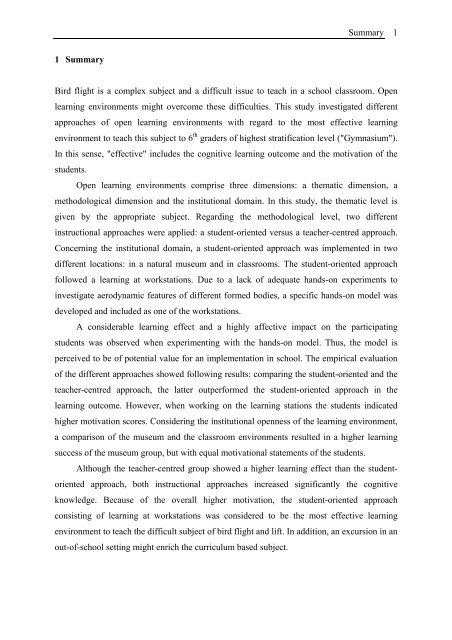Dokument_1.pdf (4369 KB) - OPUS Bayreuth - Universität Bayreuth
Dokument_1.pdf (4369 KB) - OPUS Bayreuth - Universität Bayreuth
Dokument_1.pdf (4369 KB) - OPUS Bayreuth - Universität Bayreuth
You also want an ePaper? Increase the reach of your titles
YUMPU automatically turns print PDFs into web optimized ePapers that Google loves.
Summary 1<br />
1 Summary<br />
Bird flight is a complex subject and a difficult issue to teach in a school classroom. Open<br />
learning environments might overcome these difficulties. This study investigated different<br />
approaches of open learning environments with regard to the most effective learning<br />
environment to teach this subject to 6 th graders of highest stratification level ("Gymnasium").<br />
In this sense, "effective" includes the cognitive learning outcome and the motivation of the<br />
students.<br />
Open learning environments comprise three dimensions: a thematic dimension, a<br />
methodological dimension and the institutional domain. In this study, the thematic level is<br />
given by the appropriate subject. Regarding the methodological level, two different<br />
instructional approaches were applied: a student-oriented versus a teacher-centred approach.<br />
Concerning the institutional domain, a student-oriented approach was implemented in two<br />
different locations: in a natural museum and in classrooms. The student-oriented approach<br />
followed a learning at workstations. Due to a lack of adequate hands-on experiments to<br />
investigate aerodynamic features of different formed bodies, a specific hands-on model was<br />
developed and included as one of the workstations.<br />
A considerable learning effect and a highly affective impact on the participating<br />
students was observed when experimenting with the hands-on model. Thus, the model is<br />
perceived to be of potential value for an implementation in school. The empirical evaluation<br />
of the different approaches showed following results: comparing the student-oriented and the<br />
teacher-centred approach, the latter outperformed the student-oriented approach in the<br />
learning outcome. However, when working on the learning stations the students indicated<br />
higher motivation scores. Considering the institutional openness of the learning environment,<br />
a comparison of the museum and the classroom environments resulted in a higher learning<br />
success of the museum group, but with equal motivational statements of the students.<br />
Although the teacher-centred group showed a higher learning effect than the studentoriented<br />
approach, both instructional approaches increased significantly the cognitive<br />
knowledge. Because of the overall higher motivation, the student-oriented approach<br />
consisting of learning at workstations was considered to be the most effective learning<br />
environment to teach the difficult subject of bird flight and lift. In addition, an excursion in an<br />
out-of-school setting might enrich the curriculum based subject.
















